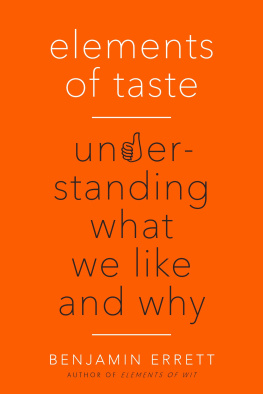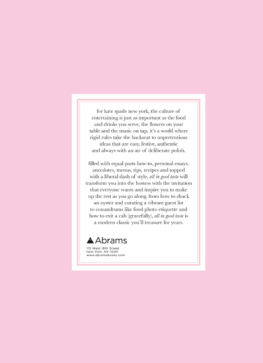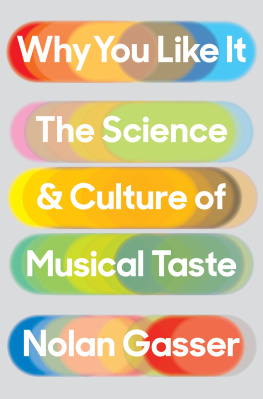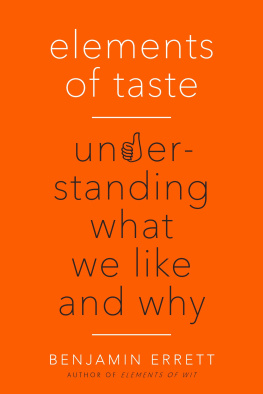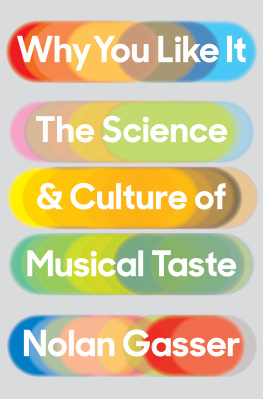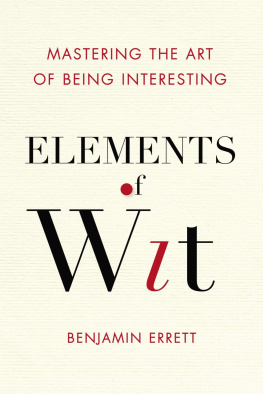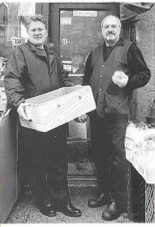Penguin supports copyright. Copyright fuels creativity, encourages diverse voices, promotes free speech, and creates a vibrant culture. Thank you for buying an authorized edition of this book and for complying with copyright laws by not reproducing, scanning, or distributing any part of it in any form without permission. You are supporting writers and allowing Penguin to continue to publish books for every reader.
Tarcher and Perigee are registered trademarks, and the colophon is a trademark of Penguin Random House LLC.
Names: Errett, Benjamin, 1978 author.
Title: Elements of taste : understanding what we like and why / Benjamin Errett.
references and index.
Identifiers: LCCN 2017020329 (print) | LCCN 2017027224 (ebook) | ISBN 9780399183454 | ISBN 9780399183447 (alk. paper)
Subjects: LCSH: Popular culture. | Aesthetics. | Taste. | Civilization,
Modern21st century.
While the author has made every effort to provide accurate telephone numbers, Internet addresses, and other contact information at the time of publication, neither the publisher nor the author assumes any responsibility for errors or for changes that occur after publication. Further, the publisher does not have any control over and does not assume any responsibility for author or third-party Web sites or their content.
Nothing classifies somebody more than the way he or she classifies.
Aperitif
Ketchup Is the Perfect Food
N ot nutritionally, of course. A steady diet of nothing but red sauce would destroy you in a matter of months. But when it comes to taste, very few foods hit all the notes the way ketchup does.
Let Malcolm Gladwell explain: The taste of Heinzs ketchup began at the tip of the tongue, where our receptors for sweet and salty first appear, moved along the sides, where sour notes seem the strongest, then hit the back of the tongue, for umami and bitter, in one long crescendo.
This was in his 2004 New Yorker story on why Heinz ketchup has proven so difficult for competitors to challenge. The king of condiments satisfies tongues on a primal level, he concludes, coming as close to being all things to all people as is possible.
It does this through amplitude, the word sensory experts use to describe flavors that are well blended and balanced. Its not just that all the tastes are there; its that theyre playing together like an all-star team.
If this can be done in the world of food, can it be replicated in other arenas? Is there a ketchup of music, of literature, of painting, of poetry?
This book says yes, there is cultural ketchup. There is Lin-Manuel Mirandas Broadway musical Hamilton. There is the original Star Wars trilogy. There is The Great Gatsby. There is Romeo and Juliet. There is George Gershwins Summertime. And there are many more.
What makes these works stand out? Theyre popular and theyre critically acclaimed, but thats not how ketchup became ketchup. It was when the key elementsred ripe tomatoes and more vinegar than seemed prudentwere finally mixed in perfect harmony. The ketchup secret was in the ingredients. To understand cultural ketchup, we have to look at the recipe. How do we get to the sweet, sour, salty, bitter, and umami of culture? We define the Elements of Taste.
When we do this, we discover not only the recipe for cultural ketchup, but also the cultural equivalents of every other taste: miso soup, Sour Patch Kids, espresso, kelp, gelato, pork chops, kumquats, ice cream. And from there, we can examine our entertainment diets from a new perspective, learning new ways to identify and satisfy cravings.
Is there a ketchup of music, of literature, of painting, of poetry?
Not everyone likes Star Wars. Some prefer to dip their fries in mayonnaise. To those people we say, dip away. This book wont tell you what to like. No book, algorithm, or person can reliably do that, and frankly its presumptuous to even try. Instead, it aims to help you think fondly about what you already loveand then offers a new framework to consider why you feel that way. And once you get an inkling of the reasons behind your passions, you can explore a new universe of songs, books, shows, and movies worthy of your love. Lets begin by turning on the radio.
1
Setting the Table : How All Taste Comes Back to the Tongue
What Sort of Music Do You Like? And How Useless Is That Question?
I ts a first-date icebreaker that sounds like something a computer would ask. Instead of getting at your innate attraction to harmony, it focuses on outdated categories. No one lingers in the car after pulling into the driveway because they need to finish a genre of music. Its just not what moves us.
Or as Shirley Bassey and the Propellerheads put it in the song History Repeating: Some people wont dance if they dont know whos singing. Why ask your head? Its your hips that are swinging.
So how do you find out what makes your hips swing?
This was a professional dilemma for David Greenberg, a psychology researcher at the University of Cambridge who set out to determine how music intersects with personality and thinking. To do so, he and his colleagues had to first figure out what sort of music people likeand how to ask them in a way that might actually get at the truth.
The issue with genre-based methods is that theyre based on peoples understanding of genres, he explains. Genres are multifaceted and broad. In the rock genre alone, you have Metallica, Joni Mitchell, Radiohead, Coldplay, and Rage Against the Machine. So someone could say, Hey, I really like rock music, but thats not giving you too much information.
Not to mention that just about every artist of note working today crosses genres in some form or another. Taylor Swift went from country to pop; Kanye West from hip-hop to electronica; Weird Al Yankovic from polka to rock to rap to polka. Each of these musicians is a genre of their own, and if you like Taylor Swift, youll likely follow her into whatever genre she tries next.
And then theres what we can call the Sloan effect, for the Canadian bands song Coax Me and its memorable lyric Its not the band I hate, its their fans. No matter how much you love blissing out to New Age music, you might not want to be a Person Who Loves Blissing Out to New Age Music. And what you sing in the shower may not be what you say to a Cambridge researcher.
And finally, music is everywhere. When your local news station transitions from sports to weather with a dubstep beat, you may find yourself humming along. SUV commercials are used to debut new tracks by respectable bands. Regular visits to the grocery store expose you to Adeles complete back catalog. Even if you never seek out a song, you may find that your musical preferences are much more diverse than you expected them to be.

